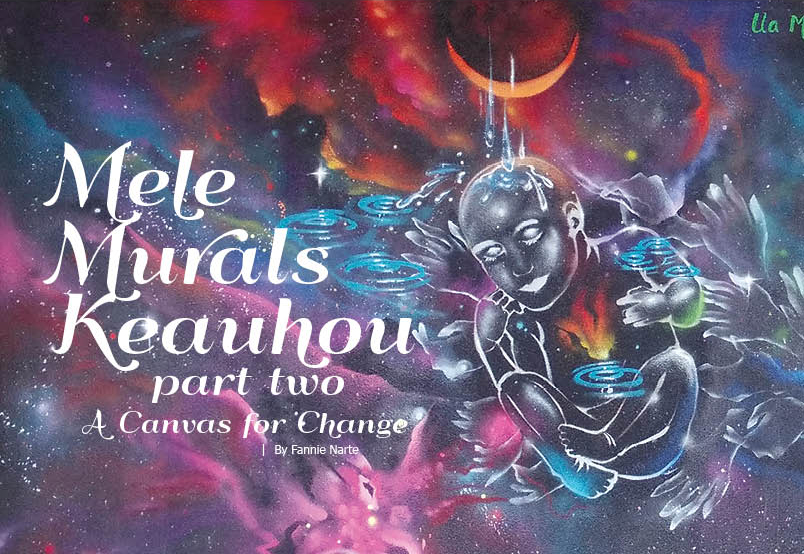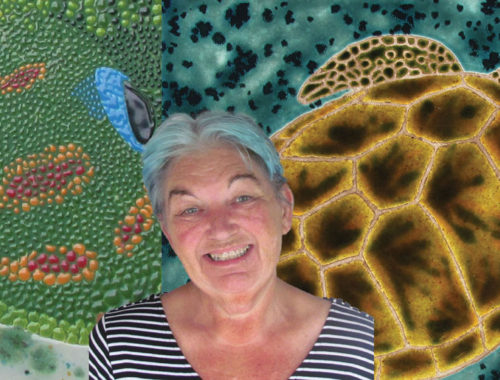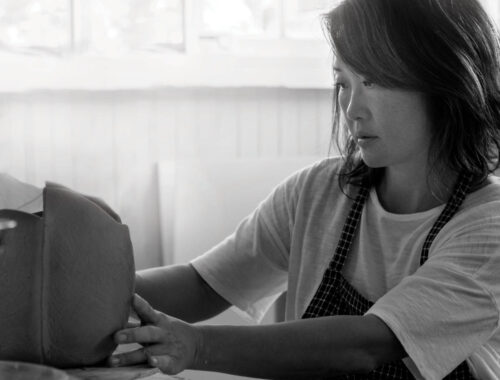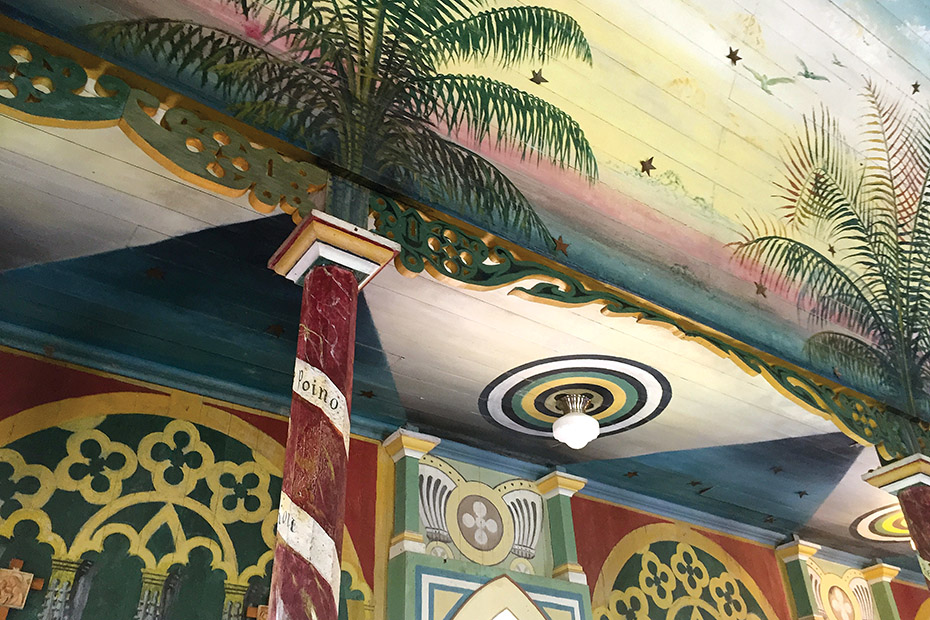
Mele Murals Keauhou, part 2: A Canvas for Change
By Fannie Narte
Estria Miyashiro, founder of The Estria Foundation, a nonprofit corporation based in Honolulu, and Mahea Akau, Mele Murals Coordinator, are transforming Hawai‘i’s visual landscape through a public art movement called “Mele Murals.” Mele Murals advances the ideals and spirit of the Hawaiian culture through the creation of a series of large-scale murals inspired by mele (songs) and na mo‘olelo (stories) of Hawai‘i. It is a project which focuses on Hawaiian youth.
The Mele Murals presented in this article complete our spotlighting of the seven panels located at the Keauhou Shopping Center in Kona, Hawai‘i Island. The stories of the other three panels were previously presented in our September–October 2015 issue, on page 25.
The Team of Participants
“Mele Murals bring people from different schools or communities together to bond and learn about our history,” says Rose Salumbides, a student at Kanu o Ka ‘Āina (Kanu) in Waimea, Hawai‘i Island.
The Mele Murals project involves youth from local programs and schools, including Hawaiian-focused charter schools. The ‘ōpio (youth) are involved in every step of the mural-making process, from securing a wall, to collaborating on a design, to creating the mural and celebrating its completion.
A team of teachers such as lead teacher Kumu ‘Ilikea Kam from Ke Kula ‘o ‘Ehunuikaimalino (KKOE), Kumu Kanoa Castro of Ho‘ala Arts (the Mele Murals club from Kanu), and a team of cultural practitioners, resources, and organizations such as Kumu Keala Ching, Tava Taupu, and Na Kalai Wa‘a have been instrumental in sharing the stories and the meaning and significance of the songs and chants in the four paintings featured in this article.
In addition, Estria, John “Prime” Hina III, Founder and Director of 808 Urban, a Hawaiian nonprofit arts organization, and a team of local artists guided the participating ‘ōpio in taking their vision from paper to the wall.
A project as enormous as Mele Murals requires many who work behind the scenes to move the work forward. Such persons are crucial supporters, members of the community, and parents of the participating students.
The Four Mele Murals
Keliko Hurley, a student from Kanu said, “These walls tell stories about how life was in Wa Kahiko (ancient times). Some of the walls represent gods and some represent the values of living the Hawaiian life. These walls remind us of how important it is to look to our surroundings for guidance and also to look for ho‘ailona (symbols). These walls will forever hold the history and stories of the values that give us knowledge.”
Kauikeaouli, Kaneaka, The Battle of Kuamo‘o, and Wa‘a, the titles of the collection of four panels to the right of the entrance of the Regal Keauhou Stadium 7 Movie Theater at the Keauhou Shopping Center, represent pono (harmony and balance). The Hawaiian perspective of harmony and balance is that which is in heaven is also on earth, and what is on land is balanced by its counterpart in the ocean. Kumu ‘Ilikea says, “To be pono is to be connected in harmony with na lani (the heavens), na kūpuna (our ancestors), na ‘aumakua (our guardians), ke akua (the supreme), ka ‘āina (the land), and kanaka (the people).”
Kumu ‘Ilikea provided the following descriptions of the four panels, which includes comments by the participating ‘ōpio.
Kauikeaouli
From pō (darkness) comes life. Keauhou is the birthplace of Kauikeaouli, Kamehameha III. This panel portrays the life force returning to the stillborn body of Kauikeaouli.
A mo‘olelo was shared with the participating ‘ōpio. It describes a crowd gathering around the deceased infant’s body, and a crazy old man, dressed in his malo (loincloth), appearing at the scene. This man told everyone that the infant was not dead and that he was only asleep. He then poured fresh spring water on the infant’s head. As the man was pouring the water, the infant’s body came back to life.
Spirits are known to reside within Papahulilani (realm of the heavens) before they enter into Papahulihonua (realm of the earth). “The hands in this panel are the hands of our kūpuna,” says Nainoa Alefaio, a student at KKOE, “kūpuna who carried the life force and spirit back into infant Kauikeaouli’s lifeless body.”
The lightning is a symbol of Kāne (a Hawaiian God). The lightning shown in the panel represents Kāne’s fingertips reaching out to the infant in affirmation of life as Ka wai ola a Kāne, the life-giving waters of Kāne. The ripples within these waters represent the great work Kauikeaouli accomplished for our people within his lifetime.
“Kauikeaouli and his decisions played a big role in Hawaiian history,” says Malie Sarsona, a student at Kanu. “During his time, many changes came to Hawai‘i. The Great Mahele and the first overthrow of the government are two of them. When the Hawaiian government was restored after being overthrown for the first time, Kauikeaouli held a ceremony for Admiral Richard Thomas, the one who restored the nation. In a speech he gave in Kawaiaha‘o Church, Kauikeaouli said: ‘Ua mau ke ea o ka ‘āina i ka pono.’ It is usually translated as, ‘The life of the land is perpetuated in righteousness.’ However, it can also be translated as ‘The sovereignty of the land is perpetuated in righteousness.’”
Kaneaka
“Kaneaka was the mural I personally worked with,” says ‘Aukai Adams, a student at KKOE. “Kaneaka is the name of the hōlua (sled) slide that King Kamehameha I built for his son.”
This panel is a depiction of an old Hawaiian tradition in which kūpuna (ali‘i) would race each other to shore; one would start at the top of the mountain and slide down on the sled while a surfer would ride a wave to shore. The first to reach the shoreline would be crowned the winner.
“I was a part of the group who created the Kaneaka panel,” says Luca Vartic, another student from KKOE. “This painting represents balance in our lives, the balance between the land and sea, including their relationship and importance to one another. It takes balance and skill to ride the hōlua sled and the surfboard effectively in order to be successful in the race,” says Luca. “We can connect this to our lives and how we need balance in order to thrive and live comfortably.”
Included on this panel is a portion of the Kumulipo, our Hawaiian creation chant, that recounts that from darkness comes life in the form of kāne (man) and wahine (woman).
“Kumulipo”
O ka lipo o ka la O ka lipo o ka po
Po wale ho‘i hanau ka po
Hanau Kumulipo i ka po he kane
Hanau po‘ele i ka po he wahine
The Battle of Kuamo‘o
“This mural shows Kuamo‘o, after the unforgettable battle that occurred in Keauhou,” says ‘Aukai. “The battle took place right down the road from Keauhou Shopping Center at Kuamo‘o,” says Luca, “so the location of the murals is very fitting.”
Lekeleke, south of Keauhou, is the site of this symbolic battle. This battle signified Hawai‘i’s transition into Westernization and the demise of the Kapu System—Hawai‘i’s primary religion for over a thousand years.
The opposing armies in this battle were both led by heirs to Kamehameha I. Kekuaokalani was in favor of perpetuating the Kapu System while Liholiho (Kamehameha II) believed the Kapu System no longer had a place in Hawai‘i’s governance.
The Battle of Kuamo‘o ended with hundreds of kanaka falling to their death with Liholiho as the victor. The fallen were entombed with unmarked lava rocks to signify that everyone was equal—regardless of their beliefs.
Depicted in the painting are “the graves of the soldiers who fell in combat,” says ‘Aukai. In addition, the painting shows “the landscape of Hualālai, the lava flowing down to the ocean, and King Kamehameha, and other Hawaiians behind him.”
The history of the Battle of Kuamo‘o includes the famous love story of Kekuaokalani and his wife Manono. Manono proved her loyalty to her husband by continuing to fight after his death. Manono was credited with slaying twenty koa (warriors) before falling to her own death beside her husband.
In this panel, “we see Manono, the great Wahine Koa, looking back at us,” says ‘Aukai. “In one hand she has a spear, and in the other she is holding her piko (navel, center), which connects us to our ancestors, and others who came before us.”
Kekuaokalani’s spirit is shown here as the ‘alalā bird (Hawaiian crow) who was said to deliver the war cry. ‘Aukai explained, “The ‘alalā was said to make a deep “yelling” sound that could be heard from far away. Kekuaokalani was compared to the ‘alalā for his war cries that instilled fear in his enemies.”
This mural is a tribute to all who have died in the name of Hawai‘i becoming prosperous as a nation. The mele, Kulāiwi, is by Hawaiian song writer, Larry Kauanoe Kimura. The lyrics of this mele resonate with the actions of Manono at Kuamo‘o: “I live for, and because of, my people, a native right and privilege.”
“Kulāiwi”
E ola au i ku‘u lāhui
He kuleana o ka ‘ōiwi
Wa‘a
This painting is the last panel and brings us back full circle to pō or night. The double hull wa‘a (canoe) represents balance and forward progress. The canoe represented here is Mauloa, a single-hull fishing canoe born in 1991. Mauloa was built by Nā Kālai Wa‘a, a group of Hawai‘i island canoe carvers. Their vision was to build from materials found on-island a canoe utilizing the traditional knowledge of our kūpuna with the help of master sailor and navigator Mau Piailug of Satawal.
Malie says, “In the background, you can see Hualālai and the beam going up to the heavens connecting it to the gods themselves.” The light beam is a ho‘ailona for us to always look to the future, looking to the mauna, our piko aligned with the zenith.
“The ripples represent the impact we, as individuals, can make with the knowledge received from our kūpuna.” In addition, Malie says, “The ripples in the water represent the effect that leaders have upon the people and how decisions of the past still affect the present.”
The lightning in this mural represents the fingertip of Kāne, calling us to do the work needed to sustain the generations to come. Ua Ao Hawai‘i is another mele written by Larry Kimura that reminds us that “with the rising of each new day, knowledge from our ancestors and knowledge from today can be ours if we want it, to make tomorrow even better.
“Ua Ao Hawai‘i”
Kau e ka wena o ke ao i ka lani
He wekeweke i ka pō pilipuka
He ‘elele o ka poniponi hikina
Kau ke kāhe‘a wana‘ao i ka ‘āla‘apapa
La‘i ana i luna o ke kūkulu o ka lani lā
‘O ka‘u ia e huli alo ne i ka ulu ē
‘Ae, ua ao ē
“Keauhou is the birthplace of chiefs and the birthplace of battles that changed Hawaiian history,” says Malie. “It is a very powerful place, and with power comes responsibility. These stories must be told so the next generations know what to do and what not to do.”
Estria, Mahea, and their large team of participants and supporters in the Mele Murals projects are documenting Hawaiian history in a creative and unique way. These murals are transforming Hawai‘i’s visual landscape. They are canvases for change bringing our nation forward—one mural at a time. ❖
Contact The Estria Foundation and Mele Murals
Contact the writer



